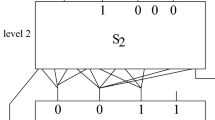Abstract
We study the consequences of NP having non-uniform polynomial size circuits of various types. We continue the work of Agrawal and Arvind [1] who study the consequences of Sat being many-one reducible to functions computable by non-uniform circuits consisting of a single weighted threshold gate. (Sat \(\leq_m^p \mathrm{LT}_1\)). They claim that P= NP follows as a consequence, but unfortunately their proof was incorrect.
We take up this question and use results from computational learning theory to show that if Sat \(\leq_m^p \mathrm{LT}_1\) then PH = PNP.
We furthermore show that if Sat disjunctive truth-table (or majority truth-table) reduces to a sparse set then Sat \(\leq_m^p\) LT1 and hence a collapse of PH to PNP also follows. Lastly we show several interesting consequences of Sat \(\leq_{dtt}^p\) SPARSE.
Access this chapter
Tax calculation will be finalised at checkout
Purchases are for personal use only
Preview
Unable to display preview. Download preview PDF.
Similar content being viewed by others
References
Agrawal, M., Arvind, V.: Geometric sets of low information content. Theor. Comput. Sci. 158(1-2), 193–219 (1996)
Allender, E., Hemachandra, L.A., Ogiwara, M., Watanabe, O.: Relating equivalence and reducibility to sparse sets. SIAM J. Comput. 21(3), 521–539 (1992)
Angluin, D.: Queries and concept learning. Mach. Learn. 2(4), 319–342 (1987)
Arora, S., Barak, B.: Computational Complexity: A Modern Approach. Cambridge University Press (2009)
Arvind, V., Han, Y., Hemachandra, L., Köbler, J., Lozano, A., Mundhenk, M., Ogiwara, M., Schöning, U., Silvestri, R., Thierauf, T.: Reductions to sets of low information content. In: Ambos-Spies, K., Homer, S., Schöning, U. (eds.) Complexity Theory: Current Research, pp. 1–45. Cambridge University Press (1993)
Arvind, V., Köbler, J., Mundhenk, M.: Bounded truth-table and conjunctive reductions to sparse and tally sets. Technical report, University of Ulm (1992)
Arvind, V., Köbler, J., Mundhenk, M.: Lowness and the complexity of sparse and tally descriptions. In: Ibaraki, T., Iwama, K., Yamashita, M., Inagaki, Y., Nishizeki, T. (eds.) ISAAC 1992. LNCS, vol. 650, pp. 249–258. Springer, Heidelberg (1992)
Arvind, V., Köbler, J., Mundhenk, M.: On bounded truth-table, conjunctive, and randomized reductions to sparse sets. In: Proc. 12th CFSTTCS, pp. 140–151. Springer (1992)
Arvind, V., Köbler, J., Mundhenk, M.: Hausdorff reductions to sparse sets and to sets of high information content. In: Borzyszkowski, A.M., Sokolowski, S. (eds.) MFCS 1993. LNCS, vol. 711, pp. 232–241. Springer, Heidelberg (1993)
Arvind, V., Köbler, J., Mundhenk, M.: Monotonous and randomized reductions to sparse sets. Theo. Inform. and Appl. 30(2), 155–179 (1996)
Arvind, V., Köbler, J., Mundhenk, M.: Upper bounds for the complexity of sparse and tally descriptions. Theor. Comput. Syst. 29, 63–94 (1996)
Arvind, V., Torán, J.: Sparse sets, approximable sets, and parallel queries to NP. In: Meinel, C., Tison, S. (eds.) STACS 1999. LNCS, vol. 1563, pp. 281–290. Springer, Heidelberg (1999)
Berman, L., Hartmanis, J.: On isomorphisms and density of NP and other complete sets. In: Proc. 8th STOC, pp. 30–40 (1976)
Bshouty, N.H., Cleve, R., Gavaldà, R., Kannan, S., Tamon, C.: Oracles and queries that are sufficient for exact learning. J. Comput. Syst. Sci. 52(3), 421–433 (1996)
Cai, J.-Y.: S\(^{p}_{2}\) ⊆ ZPPNP. J. Comput. Syst. Sci. 73(1), 25–35 (2002)
Cai, J.-Y., Naik, A.V., Sivakumar, D.: On the existence of hard sparse sets under weak reductions. In: Puech, C., Reischuk, R. (eds.) STACS 1996. LNCS, vol. 1046, pp. 307–318. Springer, Heidelberg (1996)
Fortnow, L., Klivans, A.: NP with small advice. In: Proc. 20th CCC, pp. 228–234 (2005)
Harkins, R., Hitchcock, J.M.: Dimension, halfspaces, and the density of hard sets. Theor. Comput. Syst. 49(3), 601–614 (2011)
Hitchcock, J.M.: Online learning and resource-bounded dimension: Winnow yields new lower bounds for hard sets. SIAM J. Comput. 36(6), 1696–1708 (2007)
Impagliazzo, R., Wigderson, A.: P = BPP if E requires exponential circuits. In: Proc. 29th STOCS, pp. 220–229 (1997)
Kadin, J.: P NP[O(logn)] and sparse Turing-complete sets for NP. J. Comput. Syst. Sci. 39(3), 282–298 (1989)
Kannan, R.: Circuit-size lower bounds and non-reducibility to sparse sets. Inform. Comput. 55(1-3), 40–56 (1982)
Karp, R., Lipton, R.: Some connections between nonuniform and uniform complexity classes. In: Proc. 12th STOC, pp. 302–309 (1980)
Köbler, J., Watanabe, O.: New collapse consequences of NP having small circuits. In: Fülöp, Z., Gécseg, F. (eds.) ICALP 1995. LNCS, vol. 944, pp. 196–207. Springer, Heidelberg (1995)
Maass, W., Turán, G.: How fast can a threshold gate learn? In: Worksh. Comput. Learn. Theor. & Natur. Learn. Syst., vol. 1, pp. 381–414. MIT Press, Cambridge (1994)
Mahaney, S.: Sparse complete sets for NP: Solution of a conjecture of Berman and Hartmanis. J. Comput. Syst. Sci. 25(2), 130–143 (1982)
Muroga, S., Toda, I., Takasu, S.: Theory of majority decision elements. J. Franklin. I. 271(5), 376–418 (1961)
Nisan, N., Wigderson, A.: Hardness vs randomness. J. Comput. Syst. Sci. 49(2), 149–167 (1994)
Ogiwara, M., Watanabe, O.: Polynomial-time bounded truth-table reducibility of NP sets to sparse sets. SIAM J. Comput. 20(3), 471–483 (1991)
Ranjan, D., Rohatgi, P.: On randomized reductions to sparse sets. In: Proc. 7th STOC, pp. 239–242 (1992)
Author information
Authors and Affiliations
Editor information
Editors and Affiliations
Rights and permissions
Copyright information
© 2013 Springer-Verlag Berlin Heidelberg
About this paper
Cite this paper
Buhrman, H., Fortnow, L., Hitchcock, J.M., Loff, B. (2013). Learning Reductions to Sparse Sets. In: Chatterjee, K., Sgall, J. (eds) Mathematical Foundations of Computer Science 2013. MFCS 2013. Lecture Notes in Computer Science, vol 8087. Springer, Berlin, Heidelberg. https://doi.org/10.1007/978-3-642-40313-2_23
Download citation
DOI: https://doi.org/10.1007/978-3-642-40313-2_23
Publisher Name: Springer, Berlin, Heidelberg
Print ISBN: 978-3-642-40312-5
Online ISBN: 978-3-642-40313-2
eBook Packages: Computer ScienceComputer Science (R0)



